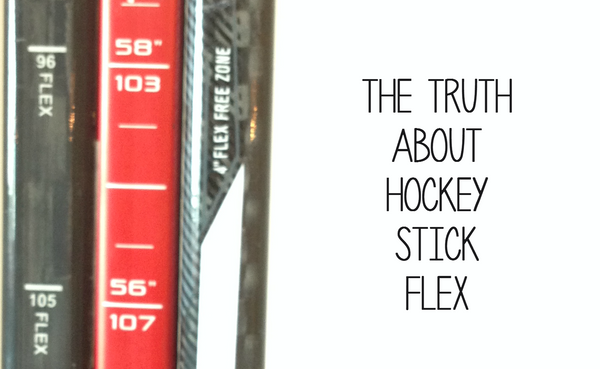The Truth about Hockey Stick Flex

We've all grown up believing that if you cut your hockey stick it will become stiffer. This, however, depends on the stick and who you ask. A scientist might argue that the composition of the stick doesn't actually change, and the properties of the woven carbon fibre remain the same. While this is true, hockey stick flex is rated in the industry by how many pounds (lbs) of pressure it takes to bend the stick 1 inch.
A trimmed down stick will now "feel" stiffer because there is less room between your hands, and by cutting down the stick you have lost leverage. This is no different than using a piece of wood to pry up an object; the more leverage you have the easier it will bend.
So years ago, in an effort to help players understand the relationship between stick length and flex, some brands began to show what the flex of a your stick would feel like when cut down. (e.g., if you have an 85 flex and remove 5 inches it will feel like you're playing with a 100 flex). This method has good intentions, but starts to get confusing for people when they get extended height pro stock hockey sticks. These sticks are generally defined as 63", 64", or 66" in height (To read more on choosing the right stick height click here). For instance, if you were to purchase two 85 flex sticks, the first being a retail model that comes with a standard 60 inch shaft and the second being a pro model with a 66 inch shaft, the flex rating on the pro stock stick is actually based on where the retail height is, and so you can cut the top of that stick down up to 6" before reaching the 85 flex mark.
The original height of the stick is something to always take into consideration. In general, flex changes by about 3 flex points for every inch you add/subtract from the stick. The effects are less noticeable in the first 2 inches however, and become more drastic the further you cut. Also, the impacts of cutting an Intermediate or Junior stick are more noticeable than cutting a Senior hockey stick (Imagine it as a percentage of the stick you are cutting off vs. a hard metric, like 1 inch).
 Ovi is well known for using a lower flex and getting lots of torque into his shots
Ovi is well known for using a lower flex and getting lots of torque into his shots
For taller players like me, who often need to use a plug/stick extension, the same principle applies. The flex will become lower (more flexible) as you increase the distance between your hands, and gain leverage to bend the stick on your shot.
Points to take away:
- The retail flex rating for cutting a hockey stick isn't always accurate or transferable to a pro stock hockey stick
- The relationship between the height and flex of a stick is very important, and changes for senior, intermediate, and junior hockey sticks
- Taller Stick = Further Distance Between Hands = More Leverage = Easier to Flex
- Shorter Stick = Less Distance Between Hands = Less Leverage = Harder to Flex
- You will find that taller players typically have a higher flex than shorter players since they have more leverage on the stick with their height
HSM









Comments (12 comments)
Mekk
While your points about “stiffness and properties of the shaft not changing” are correct, it is kind of irrelevant and unhelpful. You say only the “feel” changes but I would argue that the feel is the most important thing to measure.
I would define “feel” more specifically as the “input force” required to flex the stick = how many pounds of force to flex the stick 1". The input force is fixed for a player based on their strength/weight. And this is exactly how stick makers define “flex rating” – they are rating the players input force, rather than the stick stiffness which, as you pointed out, does not change with length.
Players need to consider the stick length and stiffness together to get the most power for their fixed input force. So it is very helpful and accurate to to have the “flex rating” measure the input force at various stick lengths.
Garret
Interesting point. But what does it change, really? I have difficulty flexing a standard 85 flex senior stick cut down for 5’6" me. If this is because I don’t have the strength, or don’t have the leverage, the result is the same, yes? I still need a lighter flexing stick, even though at 170#, 85 flex, by guidelines, is about right for me. Thanks.
Ricky
I have a pro stock stick that’s 61 inches 80 flex and was gonna add 2 inches with a composite plug would my stick feel More like a flex raining in the mid 70’s? Thanks
Keith Karant
My son is 5’10 155 he’s been using a warrior alpha QX 75 flex I need to by him some sticks. I understand that the flex is usually half your body weight but I’m assuming he’s going to be putting in weight which would make him closer to a 85 flex . What do you suggest?
wasie
If i cut down a extended stick (64 inches) with a 95 flex. To 60 inches will it still feel like 95 flex or somewhere near 107 flex
Thanks
2
Leave a comment